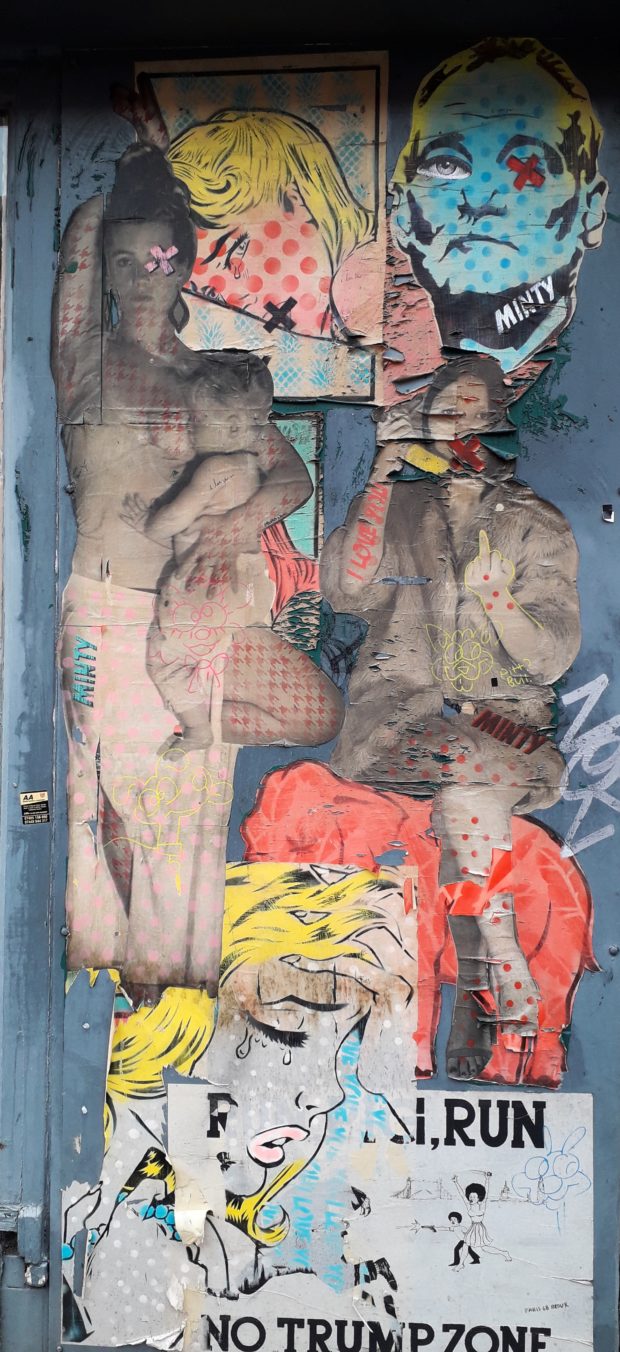You have no items in your cart. Want to get some nice things?
Go shopping
“No More Bandages” is the title of a mixed-media collage I did in the Fall of 2014. An infusion of empathy is the medical wording I would use to describe how the piece came to be. An instinctive reaction of emotional osmosis could be an equally accurate definition of what took place, though both fail in conveying the passion and the pain. There is an anatomy to this, the sheer physicality of muscles and tendons working together to lift and squeeze glue, press materials to paper, acting in synthesis with the firing neurons of the brain. Wonder at the chemicals released, the serotonin and dopamine perhaps, the hormonal irrigation of a functioning endocrine system. If samples of bodily fluids could be taken from the artist at work, the panels stained on slides, the microscopically photographed would reveal a cosmos working so naturally as to appear abstract. I see these proofs, framed or not, as suitable as the ruminations displayed at the Mütter Museum in Philadelphia; Thomas Mütter, a physician who sometime before his death in 1895 donated $30,000 and his 1,700-item personal museum of bones, plaster casts, medical illustrations and other pathological artifacts to what was then called the College of Physicians.
None of the preceding of course was going through my head while working on the collage. The impetus came from the death of a co-worker’s thirty-year-old son, an artistically multi-faceted kind-hearted man whose own writings and assemblage collage pieces, along with his medications and hospitalizations, helped give an outlet for his mental illness. Moreover and as equally relevant, his creative output provided glimpses of how effective art as treatment is during those times when the work produced makes a good case study of that illness in remission. In other words, though mental illness with its symbolic spectres and metaphors may be the subject of art for the person experiencing it, that same person may often create work along an entirely different theme. This was certainly the case for my co-worker’s son and it can also equally be found in the works of such noteworthy figures as Norman Rockwell. Rockwell’s biographer, Deborah Solomon wrote of this duality in her book ” American Mirror: The Life and Art of Norman Rockwell”, a book exploring the groundwork of Rockwell’s relationship with his psychoanalyst, Erik Erikson.
Considering letters and syllables as building blocks, sentences themselves lying within the DNA essential for the health of the brain, its ability to both construct and conceive thoughts shaped as paragraphs are an essential form of exercise, and thus the word, the concept, of catharsis comes to the fore. Trace the word back to its Greek word kathairein, meaning “to cleanse, purge.” Merriam Webster elaborates that catharsis entered English as a medical term along the lines of an emetic having to do with ridding the body, especially the bowels, of unwanted material. It didn’t take the Greeks long to see the theatric emotional aspect of the word, applying it to the writing and performing of Tragedy, even Comedy, à la: laughter is the best medicine. This alchemical artistry is of course still prevalent in such artists as Diamanda Galas, whose sonic vocal/piano work, her multi-octave “music of the spleen”, largely concentrates on the topics of AIDS, mental illness, despair, injustice, condemnation, and loss of dignity.
Wikipedia tells us the term catharsis “has also been adopted by modern psychotherapy, to describe the act of expressing, or more accurately, experiencing the deep emotions often associated with events in the individual’s past which had originally been repressed or ignored, and had never been adequately addressed or experienced.” Sigmund Freud’s colleague, Joseph Breuer used hypnosis while Freud, as an alternative, developed the idea of Free Association; i.e.; speaking or writing the content of consciousness without censor. This allowed patients to “speak for themselves”, and gain insight into the unconscious processes from which personality, the psyche, warts and all, develops. Artists may explore this with the guidance of a therapist or, in some cases, unconsciously allow their craft subscribe to the dictum: patient heal thyself. It is my belief that throughout history and the present, large swathes of humanity, whether they define themselves as creative or not, and whether their illness is mental, physical or a combination of both, valiantly attempt to do just that.
Vincent Van Gogh, of course, to a good number of the modern masses, has become the poster child for the Tortured Artist Syndrome. There is the romanticism in this based on the empirical evidence that he cut off his ear and gave it to a prostitute. There is the ultimate denouement of his being found shot in a wheat field he earlier made paintings of. The bandages which cover his head under a bruised-blue winter cap in a self-portrait painted after the ear incident would haunt even the most insensitive of viewers as much as the piercing blue gaze of the artist himself. My own poetic license now however imagines another scene no brushstrokes ever documented. In that picture, or series of them, a triptych perhaps, a film of stitched slides, the bandages are being unwound. Canvasses appear on each gauze reel unspooling slowly and gently about Van Gogh’s neck and shoulders as the wrapping is taken off. These are the other masterpieces of Van Gogh: his sunflowers, his cypresses, his blazingly humane depictions of the working class; a landlady, a postman. Altogether this is the larger presentation of how varied and complex the prolific Van Gogh was, how his spirit was larger than his wounds, his illness. His life was grand in the sense of sweeping, of immensely and deeply experienced, seen and felt. Despite lack of financial success for his talent, his life was grand and rich in the quality he brought to both its content and context.
“No More Bandages”, the mixed media collage I did both for my co-worker and her thirty-year old son was a humble homage to the kind of grandness I felt he had too in his life. The title comes from a statement he made to several people close to him at different times, the gist of it being: ” if I wore bandages to show mental struggles maybe people would understand that all wounds cannot be seen on the surface, but that it takes courage to live with them nevertheless.” I wanted to bear testament, give witness to such hard-earned wisdom since I believe if there is any point to our existence here on Earth it is perhaps simply that. At the time I did not know I was also incorporating the ancient Sanskrit theme of Namaste, one spirit nodding in acknowledgement to another as a profound form of recognition: I see you; you exist. The expression denotes dignity, respect, deserving of good care. At the very least, if not love, what more could a spirit within a body who may or may not one day be a patient, possibly want? I am not sure my co-worker’s son consistently experienced that from our United States 21st century healthcare system. Indeed, after his death, an autopsy revealed there were genuine causes for severe physical pain as real as the various diagnoses and treatments he received for his mental anguish. I am quite sure, however, that hearing such political rhetoric as we need more guns due to the level of monstrous mental illness in this society was and is not a message of Namaste or panacea for what malfunctions exist in said United States 21st century health care system. Still, broad strokes, I like to hope the majority of people who steer their carts of metaphorical gauze and bandages through the bureaucratic battleground of said healthcare system, go to work trying to do no harm even if not endowed with the Hippocratic vocation which creates a Gilead balm.
“No More Bandages”, though only a collage made with materials any school child might use, had, in its way, aspirations of actually being a bandage, an emotional one anyway. Composed of actual gauze laid over a hand painted photocopy of my co-worker’s son’s face, stickers of roses, forget-me-nots, butterflies and small warmly-glowing jewels, created a sense of depth and a sense of pressing, compressing, something like a soothing ointment both on and in. The words Live, Laugh, Dream, Love cut from different sections of a greeting card floated through the whole. They were and are blue as sky and softly curved as clouds. Of course art could hardly be more than a Mercurochrome-smeared band-aid to my co-worker’s grieving anguish, but if art is catharsis when the pain of loving and living has no cure, perhaps it has served something therapeutically useful for our brief sojourn in Time’s enduring Starry Starry Night after all.

Stephen Mead
Stephen Mead is an Outsider multi-media artist and writer. Since the 1990s he’s been grateful to many editors for publishing his work in print zines and eventually online. He is also grateful to have managed to keep various day jobs for the Health Insurance. Currently he is resident artist/curator for The Chroma Museum, artistic renderings of LGBTQI historical figures, organizations and allies predominantly before Stonewall, The Chroma Museum, https://thestephenmeadchromamuseum.weebly.com/
- Web |
- Vimeo |
- YouTube |
- More Posts(2)




